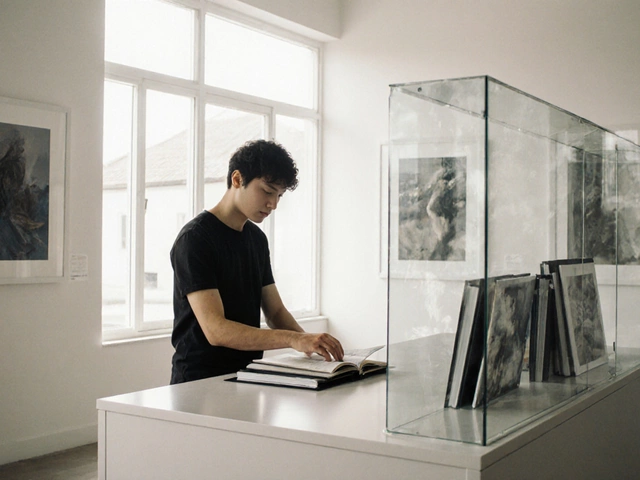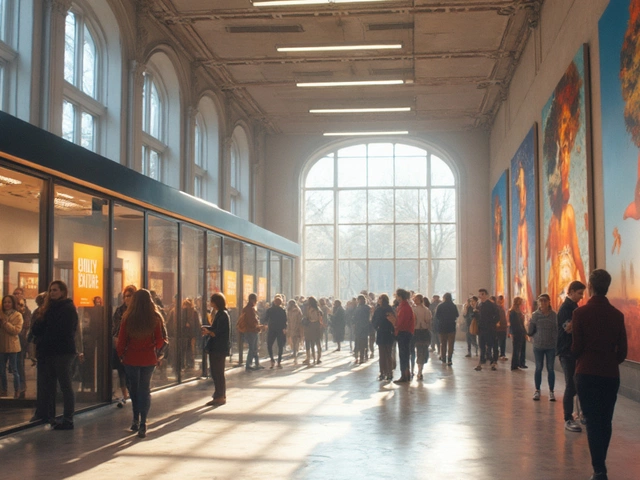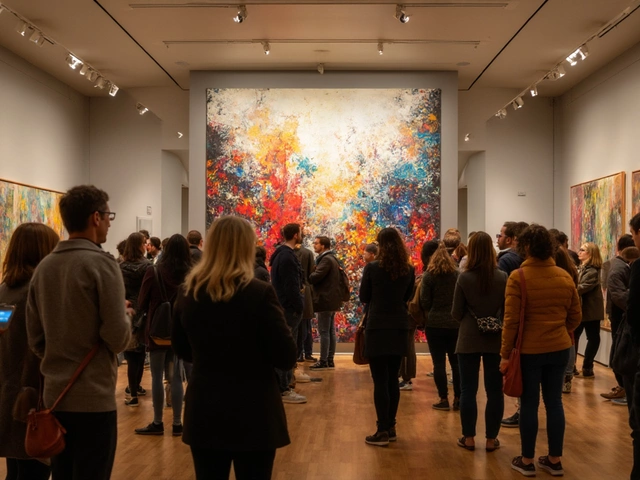The world of sculpture art is filled with varied methods and fascinating techniques, each offering unique forms of expression. Among these, sculpting and carving stand out as two pivotal practices with distinct identities. To anyone outside the art world, they may seem similar, but dig deeper, and you'll uncover the intricate details that set them apart.
Sculpting can be seen as an art of building. It's where artists mold and construct forms, often adding materials to shape their vision. This method typically uses malleable materials like clay, wax, or plaster, allowing for changes and refinements as the piece progresses. Sculpting is less about reduction and more about creation.
On the flip side, carving tells a different story. Think of it as a subtractive process—artists work by taking away from a solid block of material. Stone, wood, and ice are traditional favorites for carvers. Each stroke slices away the excess until the intended form emerges. It's a dance of decisiveness and precision, one where mistakes are harder to amend.
- Understanding Sculpting
- Defining Carving
- Materials and Tools
- Historical Perspectives
- Techniques and Skills
- Tips for Aspiring Artists
Understanding Sculpting
Sculpting is a rich and dynamic form of art that has been shaping human culture for millennia. At its core, sculpting involves the act of building and assembling materials to create a three-dimensional representation of an artist’s vision. Unlike carving, which is subtractive, sculpting is often additive. This means artists typically work by adding and forming material, allowing for a constantly evolving shape. Clay, a versatile and pliable medium, is a favorite among sculptors because it allows for an infinite number of reworks and modifications until the artist is satisfied with the final design.
One might trace the art of sculpting back to ancient civilizations, where it played a crucial role in religious and cultural expressions. The Greeks, for instance, were renowned for their exquisite clay sculptures that captured the human form with a sublime degree of lifelikeness. This tradition of sculpting has evolved over the centuries but remains rooted in the harmonious blending of material and imagination. During the Renaissance, artists like Michelangelo, known for his masterful work in both carving and sculpting, expanded the scope of what could be achieved by sculpting with materials like marble and hosts of other media.
"The sculpture is the art of the intelligence," noted Pablo Picasso, emphasizing the thoughtful process involved in creating sculptures.
Today's sculptors have a plethora of materials at their disposal, ranging from traditional clay and stone to modern materials like metal and fiberglass. These materials each have their own properties, offering unique challenges and benefits. Clay, for instance, can be easily manipulated when wet, providing flexibility to the artist. Once fired, it becomes hard and durable, capturing the intended form. On the other hand, metals such as bronze require a different approach, often involving casting rather than direct modeling.
When diving into the world of sculpting, understanding the basic techniques is essential. Artists often begin with sketches to conceptualize their ideas before moving on to sculpting small-scale models called maquettes. These initial models are crucial as they allow artists to experiment with proportions and perspective. Once the maquette meets their vision, artists can scale up to create the full-size sculpture. This process demonstrates the necessity of planning and precision in sculpting.
For aspiring sculptors, developing a keen eye for detail and a steady hand are vital skills. The nuanced handling of materials and tools, such as modeling tools and wire armatures, requires practice and patience. It is not uncommon for a project to take months or even years to complete, particularly when working on large-scale public sculptures. These time investments reflect the dedication of sculptors to bring their imaginative concepts to tangible life.
Defining Carving
Carving is an ancient art form grounded in the tradition of turning raw, unformed materials into exquisite, expressive works of art. At its core, carving entails the subtractive process of shaping by removing material from a solid mass. This might involve chiseling away at a block of marble, delicately shaving slices of wood, or chipping off fragments of stone until a sculpture reveals itself from within.
The origins of carving stretch back thousands of years, with evidence of this practice found in various ancient civilizations. The Egyptians, for instance, crafted elaborate sculptures from limestone and sandstone, forming detailed representations of deities and pharaohs destined for the afterlife. In more recent centuries, artists like Michelangelo have demonstrated that an entire universe can be borne from a single block of marble, his David standing as a testament to this transformative power.
Materials used in carving range from the soft and workable to the hard and resistant. Wood, especially types like mahogany, oak, and basswood, is favored for its versatile nature, allowing for intricate details and rapid cuts. Stone, on the other hand, provides a more enduring medium, its granular surface and tonal richness offering a permanence that speaks across ages. Other materials include ice, as seen in majestic ice sculptures, and soapstone, prized for its smooth texture.
Tool selection plays a crucial role in the art of carving. Essential implements include chisels, gouges, and mallets. Each tool serves a unique purpose—from the gouge, perfect for cutting out broad sweeps, to the fine-pointed chisel used for creating delicate lines and textures. The interplay between tool and material demands a balance of strength and finesse, patience and precision.
Carving Techniques
Carving techniques can be broadly categorized into whittling, relief carving, and full-round carving. Whittling is the simplest, requiring only a knife, and is commonly associated with the creation of small wooden objects or figures. Relief carving involves sculpting an image in raised detail on a flat background, often seen in intricate ornamental designs. Full-round or in-the-round carving produces three-dimensional works, viewable from all angles, requiring meticulous attention to form and balance.
Michelangelo famously described his process as "Every block of stone has a statue inside it, and it is the task of the sculptor to discover it."
This perspective highlights the philosophical and creative aspects that set carving apart. As a practice, carving demands both vision and intention—it isn't merely about reducing material but understanding and unveiling potential hidden within the mass. Knowledge of the material's properties allows the artist to anticipate how it will react to each cut, fostering a dialogue between hand, tool, and medium.
The rewards of carving lie not only in the finished artifact but in the journey of its creation. The intimate, tactile relationship that develops between carver and material promotes an appreciation for texture, form, and the natural beauty of the medium. This echo of the past in a present form captures the transcendence and timelessness inherent in the art of carving, making it continuously relevant and compelling even in our modern age.

Materials and Tools
The tools and materials chosen for sculpting and carving are crucial, guiding not only the form and texture of the final piece but also the process of creation itself. The medium speaks to the artist, determining the tools and techniques they'll employ. In sculpting, pliable materials like clay, wax, and plaster are favorites, loved for their versatility and ease of use. These materials can be pinched, prodded, and molded with bare hands or simple tools like loops, spatulas, and ribs. Modern sculptors often look to advanced materials such as polymers or resins for unique properties and durability, enhancing their creative possibilities.
On the other side, carving leans on more rigid materials. Wood and stone come to mind immediately, classic choices that have been used for millennia, perhaps epitomized by the intricate stonework of Michelangelo or the detailed wooden sculptures in various cultural iconographies worldwide. The tools for carving are equally specialized, often including chisels, gouges, and mallets to chip away at the material. Different chisels produce different effects, whether you're aiming for broad strokes or fine details. As technology advances, power tools and laser cutters join the carver's repertoire, allowing for even more precision and efficiency.
Choosing the Right Materials
Selecting the right material often reflects the intended longevity and aesthetics of the piece. Stone sculptures stand the test of time, requiring minimal maintenance, while wood, though susceptible to environmental conditions, offers a warm, organic beauty. Each choice poses different challenges and rewards; a carver must understand their material as thoroughly as a sculptor knows their clay. A famous sculptor once remarked, "The material does not dictate the art, the artist and the material find harmony," highlighting the synergy needed between artist and substance. These choices are not merely pragmatic but philosophical, often influencing the narrative or spiritual essence of the artwork.Historical Perspectives
Sculpture art, encompassing both sculpting and carving, has meandered through human history, tracing the evolution of our civilizations and cultures. From as early as the prehistoric era, human beings have engraved and molded to depict daily life and spiritual beliefs. The statues of Venus, dating back to about 25,000 BCE, are among the oldest examples of carved figures. These early works were carved from bone, antler, and stone, showing that humans have had a long-standing relationship with transforming raw materials into forms of significance.
The classical antiquity period, particularly in ancient Greece, witnessed a profound advancement in both carving and sculpting techniques. Greek artists perfected the art of capturing human anatomy with stunning accuracy, creating masterpieces like the statues of the Parthenon. They predominantly used marble for carving, a material revered for its durability and beauty. During the same era, bronze became a favored medium, attributed to its versatility and strength, fostering the art of sculpting. As Pliny the Elder noted, these sculptures not only reflected idealized human forms but also conveyed the cultural zeitgeist of their times.
During the Renaissance, sculpting saw a remarkable resurgence in Europe. Artists like Michelangelo emerged, bringing a new dimension to sculpture art. Michelangelo's “David,” carved from a single block of marble, stands as a testament to the artist's prowess and understanding of the human form. This period marked a renaissance not only in the visual aesthetics but also in the methods used in sculpture art. Techniques were refined, and the significance of these artworks extended beyond religious themes to embrace secular humanism. It was an era where carving techniques in particular saw significant improvisation alongside the burgeoning of sculpting skills.
"Every block of stone has a statue inside it, and it is the task of the sculptor to discover it," reflected Michelangelo, encapsulating the essence of carving.
The 20th century brought modernism, altering perspectives on sculpting and carving yet again. Artists explored abstract forms, breaking traditional boundaries. Constantin Brâncuși, often known as the pioneer of modernist sculpture, stripped forms to their elegance essentials, marking a departure from realistic representation. Sculptors started incorporating industrial materials like metal and plastic, embracing technological advancements to expand their craft. The presence of both carving in forms like relief sculptures and the progressive models of sculpting demonstrated how diverse influences enriched the art form. As contemporary art continues to evolve, both sculpting and carving remain integral, highlighting humanity's enduring connection to creativity and material expression.

Techniques and Skills
Delving into the techniques and skills required for sculpting and carving not only reveals the complexity of these art forms but also showcases the different approaches that artists can take. When it comes to sculpting, artists often begin by conceiving a vision which they then bring to life through various stages of model construction. Common materials like clay, wax, or plaster provide the flexibility to explore forms and refine details. This flexibility offers a learning curve encouraging experimentation. The methods used for sculpting can range from classic techniques like modeling—a process of adding materials—or casting where molten materials are poured into molds. Often, larger sculptures encourage the use of frameworks or armatures to provide structure and stability beneath softer sculpting materials.
A completely different skill set is honed by the carvers whose prime directive is to remove excess material from their chosen medium, be it wood, stone, or even marble. This subtractive technique demands patience and precision. The approach can be intensive as each cut is permanent, making foresight as crucial as creativity. To guide their efforts, carvers often begin with a maquette or a smaller model to envision the finished piece. Specialized tools—chisels, gouges, mallets—become extensions of the artist's hand, each with its unique function for surfacing, detailing, and shaping. One notable aspect is that carving as an art form barely allows room for error—the skill here is tantamount to being comfortable with what's permanent.
Mastery and Innovation
As with any art, mastery requires practice and dedication. The line between different techniques and personal style often blurs with experience and innovation. Many famous sculptors, like Michelangelo, have been known to transcend traditional techniques, treating the material not just as a medium but as a canvas on which ideas would manifest saying, “I saw the angel in the marble and carved until I set him free.”
Michelangelo's statement is a testament to the philosophy behind every carve—that each stone holds a hidden truth awaiting discovery by the carver's patience and skill.Notable contemporary artists further dissect these traditional boundaries with advanced techniques, including laser cutting or computer-aided design (CAD) to complement their manual skills. This doesn't just add precision but also expands what's possible artistically.
For those interested in starting their journey into sculpture art, understanding these varied techniques is critical. Resources are plentiful, from online tutorials to workshops offering hands-on experience. The key is to engage with materials directly, gaining an intimate understanding of their properties and potential. A piece of advice often shared is to start small and gradually undertake larger projects as confidence grows. Embrace mistakes as part of the learning curve—whether sculpting or carving—and let each experience guide future creations. An artist's mastery, ultimately, lies in knowing their tools intimately and allowing the material to guide their creativity to fruition.
Tips for Aspiring Artists
Embarking on a journey into the fascinating arenas of sculpting and carving can be both exhilarating and daunting. To help navigate these art forms, it’s important to start with a solid understanding of the mediums and the techniques which serve as their backbone. First, immerse yourself in the wide range of materials available. Whether you favor the forgiving nature of clay for sculpting or the challenging yet rewarding process of carving hardwood, learning how each material responds to different tools is crucial. Spend time practicing with different substrates to develop a feel for how they shape and change under your hand, allowing your confidence in manipulating these materials to grow.
Consistency and practice cannot be overstated. Dedicate regular time slots to your craft in order to build your skills, no matter how small. This practice translates directly into the mastery of both the hand and the eye. As you work, build a foundation of technical knowledge while letting creativity flow, understanding that both learning and improvisation are key components of the artistic process. Studying the techniques of masters in sculpture art, attending workshops and seeking mentorship can provide invaluable insight. Remember to revisit historical totems in art, examining the works and techniques of renowned sculptors and carvers like Michelangelo for inspiration and technical guidance. Reflect on how their innovations have impacted contemporary practices.
Establishing a community is paramount. Engage with fellow artists and join communities where artists share critiques and support. This network can become a lifeline, offering fresh perspectives and constructive feedback. Additionally, explore the technological tools and resources available to modern artists. Digital sculpting platforms, for example, can be a fantastic way to experiment with forms before setting chisel to stone. Never underestimate the importance of continuously pushing the boundaries of both your technical skills and creative vision. Embracing new technologies and innovative techniques can energize your practice, keeping your approach fresh and contemporary.
“The true work of art is but a shadow of the divine perfection.” – Michelangelo
It’s essential to approach failures as stepping stones. Mistakes are part of the creative process, serving as opportunities for growth. An artist should never fear the destruction that comes with carving away parts of their work or starting a sculpture from scratch. Take time to analyze what went wrong and how the outcome can inform your subsequent endeavors. Each setback is a learning experience that enriches your future projects. Finally, nurture your personal motivation and artistic philosophy. As you develop your style, let your unique voice shine through. Explore themes and ideas that resonate with you personally, which will make your art meaningful not only to you but also to those who experience it.





